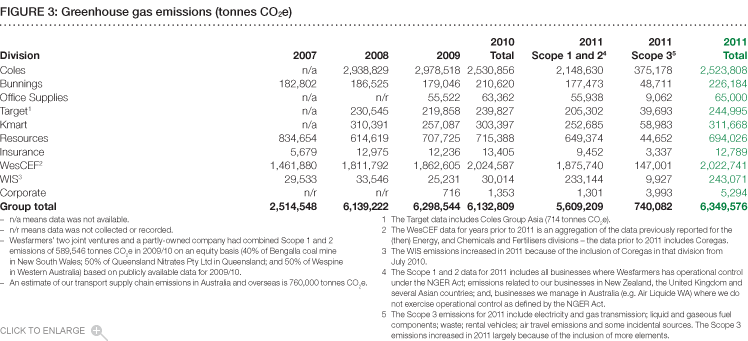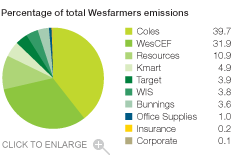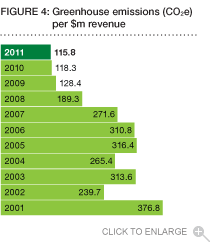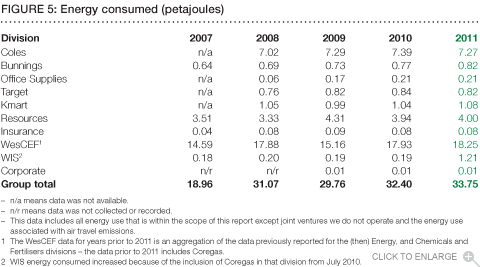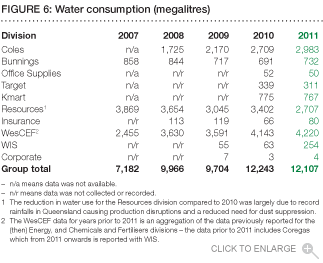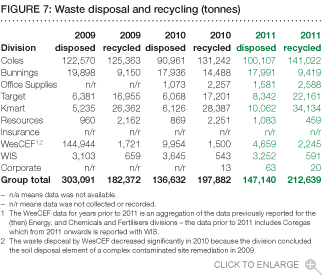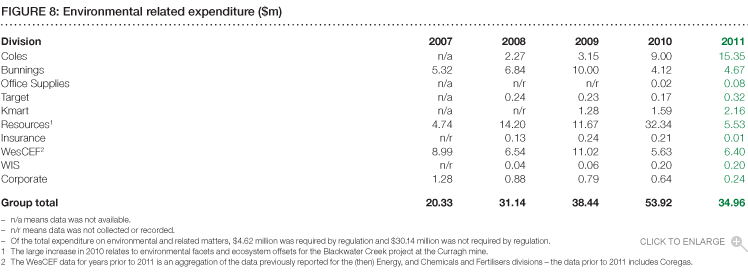Sustainability scorecard
Environmental
Wesfarmers' diversified businesses, and its geographical spread across Australia and New Zealand, means the company is responsible for managing a wide range of environmental issues. Because of this diversity, Wesfarmers requires business units to develop policies and procedures that are relevant to their particular circumstances while ensuring that these are in line with the broader Group's principle of placing strong emphasis on protection of the environment. Across the Group, a number of significant environmental programs are being developed and implemented, many of which are outlined in the respective divisional reports.
Group environmental indicators
The information in this section includes data from five years wherever possible. Some of our businesses find that water and waste are difficult to accurately measure because of the shared location of their facilities, so they have developed estimation techniques, while some of the former Coles group of companies did not collect some of this data prior to being acquired by Wesfarmers in November 2007. These estimations or lack of recorded data are highlighted in the report.
Greenhouse gas emissions
Wesfarmers reports under the National Greenhouse and Energy Reporting Act 2007 (NGER Act). This system records the majority of Australia's greenhouse emissions and energy use. Wesfarmers registered under the NGER Act in October 2008 and operates a Group-wide, internet-based, information management system to manage our NGER Act reporting obligations, and also to inform and monitor our many energy efficiency programs in the future.
The NGER Act covers Scope 1 and 2 emissions; does not include some significant emission sources such as the sodium cyanide business at our Kwinana operations or certain refrigerant gases; and introduces the concept of operational control (which means, for example, a Coregas air separation unit in New South Wales and several remote power generators in Western Australia are reported for NGER Act purposes by our clients). This means that some of our data is not directly comparable year on year, but where possible this is explained in the text and this report covers all emissions we are responsible for.
At the time of this report's preparation, Wesfarmers recorded 5,044,231 tonnes carbon dioxide equivalents (CO2e) (Scope 1 and 2 emissions) in our NGER Act report for 2010/11. This Sustainability Report declares a total of Scope 1, 2 and 3 emissions of 6,349,576 tonnes CO2e (a difference of 1,305,345 tonnes CO2e).
The difference is created by the definitional and legal requirements of the NGER Act with the major components (all quoted as approximate data in tonnes CO2e) comprising:
- Scope 3 electricity transmission emissions (401,600)
- air travel emissions, calculated to include a forcing factor to account for emissions by aircraft at cruising altitude (38,200)
- refrigerant gases excluded from the NGER Act (33,600)
- Air Liquide WA, which is reported under the NGER Act by Air Liquide Australia (89,000)
- New Zealand and other country emissions (12,000)
- the sodium cyanide plants we operate for Australian Gold Reagents (a 75 per cent owned joint venture) (82,600) –this production process is not included in the NGER Act Determination
- the Coregas air separation unit at Port Kembla, New South Wales, which is deemed for NGER Act purposes not to be under the operational control of Coregas (197,700)
- other emissions including gas transmission factors, use of rental vehicles and waste-related emissions and some industrial emissions not able to be recorded under the NGER Act (450,000).
Our total direct and indirect greenhouse emissions for the Group in 2010/11 were 6,349,576 tonnes CO2e (figure 3). This was 216,767 tonnes above emissions reported for last year; however, the 2010 data did not include air travel emissions or the Coregas air separation unit at Port Kembla, which would have increased the emissions reported in last year's report by 235,900 tonnes to 0.3 per cent above the level reported this year.
Our NGER Act report for 2010/11 reflected a decrease of 2.3 per cent, compared to the 2009/10 NGER Act report.

The decrease in emissions this year (Scope 1 and 2 in the NGER Act) occurred in most of our divisions – despite business growth across the Group – and resulted largely from: energy efficiency investments in our retail businesses; the investment in nitrous oxide emission reduction at CSBP in Kwinana (a business in the Chemicals, Energy and Fertilisers division), which is expected to provide further reductions in direct emissions in future years; and the reduction in production at our Curragh mine in Queensland, which in turn reduced reported methane-based fugitive emissions (the NGER Act requires this to be calculated according to a formula driven by coal mined).
Wesfarmers continued to participate in the Carbon Disclosure Project (CDP) in 2011. Our submission is available on the CDP website at www.cdproject.net and provides full disclosure on our greenhouse emissions and our approach to climate change issues. As part of our efforts to reduce emissions, we continue to contribute to a major emissions reduction initiative, the Coal21 Fund, which levies coal producers to fund research into low emission coal technologies. Our contribution to this fund is likely to reach $30 million over 10 years.
The diversity of our business operations provides some difficulty in developing Group-wide metrics to enable review of our emissions performance over time, other than the data provided in figure 3. Figure 4 shows our reported emissions per million dollars of revenue from the year 2001, which explains our capacity to improve emission intensity over time (in these 10 years there have been significant changes in the Group's business activities).
We are also an investor in two joint ventures and a company in Australia which report under the NGER Act – the Bengalla mine in the Hunter Valley, New South Wales (40 per cent owned by Wesfarmers and operated by Coal and Allied); Queensland Nitrates Pty Ltd at Moura in Queensland (50 per cent owned by Wesfarmers and operated as a separate management entity); and the 50 per cent owned Wespine sawmill in Western Australia. Our equity share of the 2009/10 emissions (the most recent publicly available data) reported under the NGER Act by these three businesses was 589,546 tonnes CO2e. The 2010/11 NGER Act reports by these businesses, and Wesfarmers Limited, will be published in February 2012.
Energy use
The total estimated energy use for our Group in 2010/11 was 33.75 petajoules, an increase of approximately 4.2 per cent on last year, which is slightly lower than business growth. Our energy use is summarised in figure 5.

Wesfarmers is registered under the Federal Government's Energy Efficiency Opportunities Act (EEO Act), with an amended Assessment and Reporting Schedule for our Group gaining regulatory approval in May 2010. The approved schedule incorporates assessment of at least 92 per cent of all Wesfarmers energy use.
We submitted our third public and government reports under the EEO legislation in December 2010, and the public report is available on our website at www.wesfarmers.com.au
The Group energy usage in our 2010/11 NGER Act report will be different to the data in figure 5 below. The difference relates to legal and definitional issues required by the NGER Act, and largely relates to: natural gas passed through our Kleenheat LPG operations at Kwinana, Western Australia, which is not actually converted to product or combusted, but which has to be counted in the NGER Act report (12.84 petajoules); and the enGen remote area power stations which are not under our operational control for NGER Act purposes and therefore are reported by our mining company customers (3.57 petajoules).
Water consumption
Estimated water use (scheme, surface and ground water) across the Group totalled 12,107 megalitres (figure 6). Last year's estimated total Group consumption was 12,243 megalitres. The reported decrease is largely due to reduced water use at our Curragh mine in Queensland, mainly as a result of the Queensland floods.

Our total water use included 2,255 megalitres of ground water (largely at our mine sites and industrial operations); 1,745 megalitres of treated water from recycled sewage waters at CSBP's chemical manufacturing operations at Kwinana and 1,575 megalitres of surface water harvested at our mine sites.
We are continuing to improve the accuracy of this data in the areas where we estimate water use, particularly for retailers other than Bunnings, where shared facilities are common.
Waste
All of our retail businesses are signatories to the Australian Packaging Covenant (APC) through the registration of Wesfarmers Limited in 2010 – the APC replaced the previous National Packaging Covenant (NPC) in which Wesfarmers and our retail businesses also participated. The APC is, similar to the NPC, a voluntary packaging waste reduction and recycling initiative underpinned by a National Environment Protection Measure and all our retail businesses reported publicly on their activities in October 2010 as our final report under the provisions of the NPC – this report is available at www.wesfarmers.com.au
During the year, our businesses disposed of 147,140 tonnes of waste to landfill and the Group data is presented in figure 7. This is a 7.7 per cent increase on waste disposal compared to last year. The data is materially complete with only data from the Insurance division not included, largely because of the difficulty in measuring waste disposal at many small offices, many sharing facilities with other organisations.
In some of the business unit reports there are comments on many of the waste reduction and recycling initiatives undertaken across the Group. As a result of these programs and initiatives, our retail businesses recycled more than 206,000 tonnes of consumer packaging materials during the year.
Liquid waste data is difficult to collect for most of our facilities because it is represented by unmetered discharges to public sewerage systems and in some cases liquid wastes delivered to appropriate treatment plants. Our coal mines also discharge ground and rain water from their mine voids under licence with the relevant authorities. CSBP at Kwinana, Western Australia, has a discharge licence to a treated waste water system that eventually discharges to the Indian Ocean.
Non-compliance/prosecutions
We are not aware of any significant non-compliance with environmental regulations or any prosecutions relating to environmental issues during the year other than disclosed in the various business reports.
In total our businesses reported four potential or actual non-compliances with environmental licences or other regulatory instruments (two each in WesCEF and Resources) and five exceedances of a target licence effluent concentration (but not a licence condition) at CSBP in Kwinana, Western Australia.
National Pollutant Inventory (NPI)
Resources and Chemicals, Energy and Fertilisers are required to report under the NPI. Full details are available on the NPI website www.npi.gov.au, with 2010/11 data available in January 2012.
Environmental expenditure
Total environmental expenditure, including land remediation costs for 2010/11, is $34.96 million (figure 8). This compares with last year's total of $53.92 million, the difference largely due to the completion of the Blackwater Creek diversion project at the Curragh mine site. These costs include salaries and overheads, specific environmental projects and any other costs (such as fees paid to consultants and capital expenses) for an environment-related purpose, which can include emission reduction, effluent management, revegetation and energy efficiency.

Contamination
Remediation of site contamination is an issue for some of our businesses. Wesfarmers is responsible for the remediation of several sites and financial provision has been made to cover the estimated cost of these activities.
CSBP is engaged in the remediation of a former fertiliser site at Bayswater in Western Australia, which has been reported on previously. Active remediation has concluded at the site and activity now relates to monitoring and the statutory audit processes.
During the year, Wesfarmers made some significant progress at a site in Manjimup, Western Australia, formerly owned by Sotico. Extensive monitoring and review led to six properties owned by third parties near the site being reclassified as 'Not Contaminated – Unrestricted Use' under the provisions of the Western Australian Contaminated Sites Act 2003 in August 2010. These properties had previously been classified as 'Contaminated – Remediation Required' under the Act. The monitoring on the site, following the extensive remediation activity reported last year, continues to show considerable positive progress.
Monitoring and risk assessment continued variously at the former Wesfarmers Transport sites in Kewdale, Carnarvon and Port Hedland in Western Australia. The Carnarvon site was reclassified under the Contaminated Sites Act 2003 as 'Remediated for restricted use' in September 2010, which allows its intended use to be pursued by the current owners. Remediation outcomes at the Kewdale site have progressed to the stage where Wesfarmers will seek a similar regulatory outcome for that site in 2011/12.

